Why Is My Baby Not Using Her Left Leg to Crawl?
Welcome to PART 1 of my 3-office series on crawling!
Today I am excited to explore with you how babies develop the ability to clamber.
Babies tend to begin scooting frontward on their belly like a wiggly little lizard between almost eight-9 months and then, on boilerplate, accept their first official crawling "steps" on hands and knees with belly off the flooring between 9-11 months of age.¹
Once they brainstorm zipping effectually on their easily and knees, babies then continue to use crawling as their master ways of mobility for approximately 4-half dozen months until they transition to becoming independent walkers.² Though that may audio fairly straightforward, the preparation leading up to crawling begins long before baby always takes those get-go victorious steps on hands and knees.
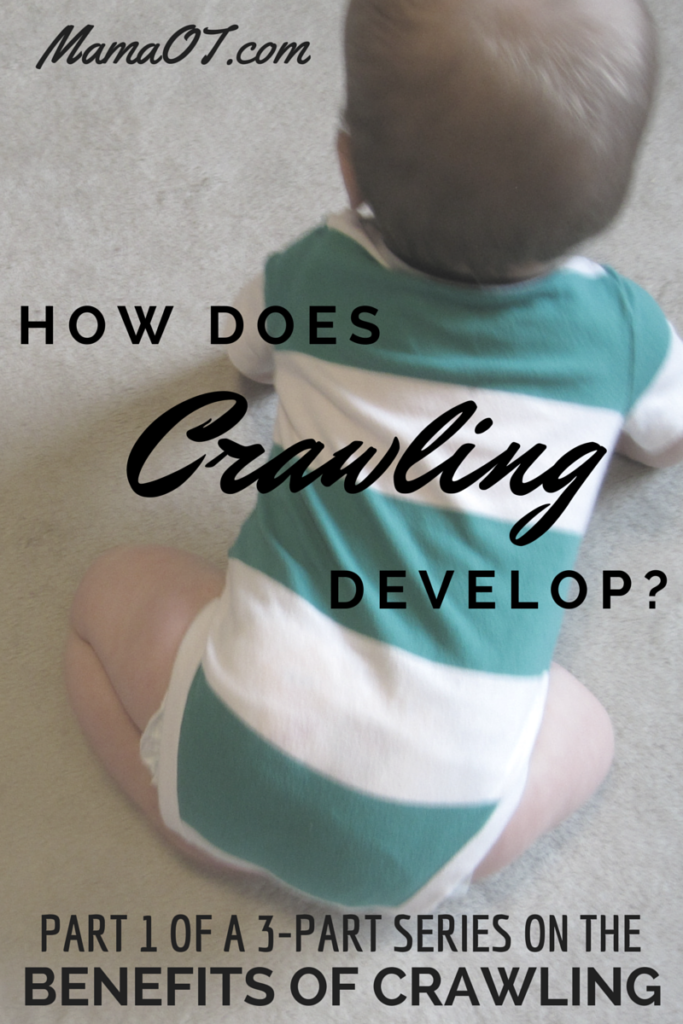
Motor milestones that oft come before the advent of crawling include:
⇒Between 2-3 months one-time: Becoming comfortable in the prone (tummy downward) position while lifting their head and smoothly turning it to both sides without bobbing up and down. This comes from time spent playing on their tummy (aka – tummy time!). Endeavour out these tips for making breadbasket time easier for your baby, plus this idea for how to use an exercise ball to make tum time non just easier only more fun for y'all and your baby.
⇒Between ii-4 months former: Existence able to back up their weight on their forearms while playing on their breadbasket. This tin can be expert by taking the legs off a baby play table as well every bit by playing on an exercise brawl or in front of a mirror.

⇒Between 4-6 months quondam: Being able to carry weight on their hands while pushing their entire chest off the flooring.
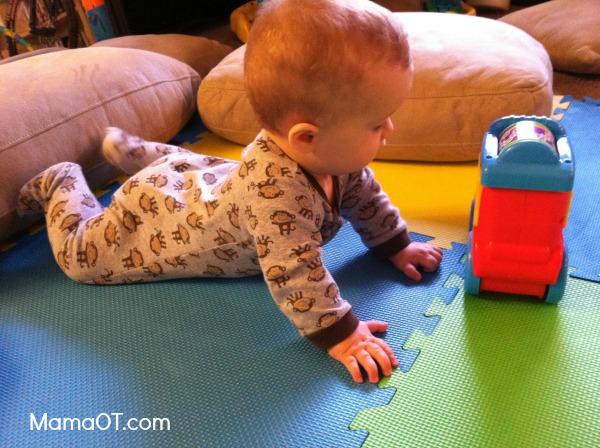
⇒Also between 4-vi months one-time: Integrating the Asymmetric Tonic Cervix Reflex (ATNR). Don't get scared off by all those weird, clinical words! The ATNR reflex is something you've likely seen babies demonstrate a hundred times without realizing what it was. ATNR is observed whenever baby lays on his back and his caput is turned to i side. This causes the arm and leg on that same side to automatically straighten out while the arm and leg on the opposite side bend, bringing the mitt backside the head in what is causally referred to as the "fencing pose". (See beneath)
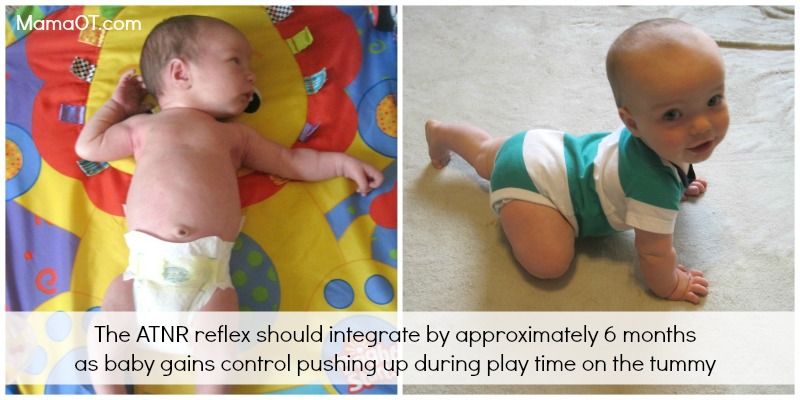
As baby learns to push his breast up off the floor during tummy fourth dimension and turn his head to the left and to the right while doing so, this automatic ATNR reflex should begin to disappear (or "integrate"). Information technology's important to know that, in guild for this reflex to integrate, babies need Practise, PRACTICE, PRACTICE playing on their tummy in the first 6 months of life! When babies do non integrate the ATNR reflex (which and so persists into childhood) it tin can take some interesting impacts on later development, peculiarly as it relates to playing, reading, and learning.
⇒Between 6-7.5 months quondam: Beingness able to push their chest off the floor and then shift their weight to ane hand while reaching out for a toy with the other. This becomes much easier for babies once the ATNR is integrated considering it allows them to appoint in play at the heart of the torso ("midline") while in the tummy-downwardly position, which is a HUGE pre-requisite for crawling!
⇒Between 6-8 months former: Beingness able to lay on their tum and bend one knee joint forward side by side to their torso equally they attempt to scoot forward. Once more, this is so much easier to exercise when the ATNR is no longer responsible for "automatically" controlling movements because at present baby can practise moving the arms, legs, and head separate from each other. Tin can you imagine how difficult it would be to scoot or crawl forward on your belly if, every time y'all turned your caput one style, the arm and leg on that side of your body straightened out? Try it for yourself. Seriously challenging.
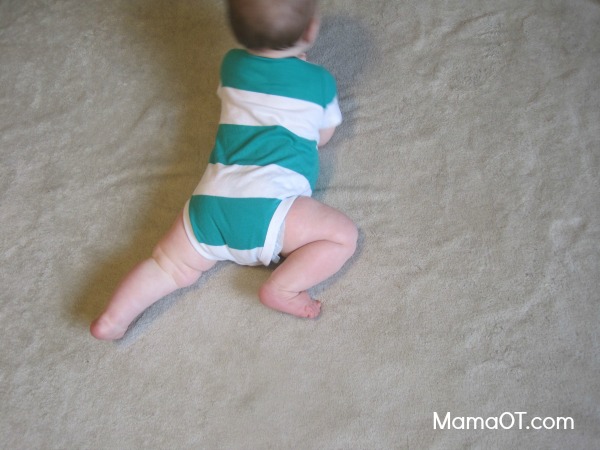
⇒Likewise between 6-8 months old: Demonstrating "protective extension" responses of the arms to the front and both sides. This means that, when baby is sitting and begins to lose balance forward or sideways, his artillery shoot out to try and grab himself. I've referenced the development of this protective response before in my postal service on rolling a brawl with your babe to promote development. That protective response is what allows infant to larn how to transition from an upright sitting position downwardly to a easily-and-knees position, making him a "functional sitter" and giving him another skill in his arsenal of independent mobility tools.
⇒Between half dozen-9 months one-time:Demonstrating emergence of the Symmetrical Tonic Neck Reflex (STNR), which you tin can also refer to equally the "itch reflex". STNR occurs when babies lift their head, causing their artillery to straighten and button into the ground while also causing them to bend (flex) at the hips and knees so they can deport weight on their knees. You lot can see how this would exist important for helping babies larn to crawl, right? This reflex likewise occurs in the reverse management — when baby tucks his head down to his chin, his arms bend and his legs straighten out so it makes it look like he'due south doing a Downwardly Dog pose.

STNR typically integrates (there'due south that give-and-take again!) just before babe'southward first altogether (around xi months, once it's no longer needed to help baby crawl). And, just like ATNR, an STNR that does not integrate on time can have some unexpected impacts on after development every bit it relates to playing and learning.
⇒Between viii-nine months old: Independently supporting their weight on hands and knees, known equally the quadruped position. Babies often assume this position and and so begin experimenting with rocking forward and back, side to side, and diagonally while staying in place, as if trying to wind themselves up to go for it and crawl. It's so cute!
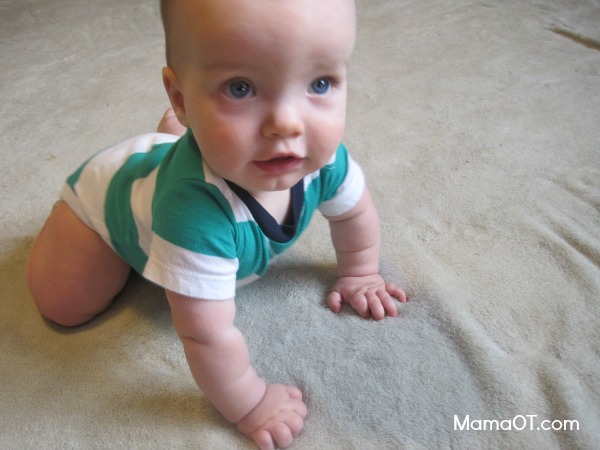
See what all that rocking and rolling looks similar in the brusk video prune below (a couple weeks before infant started crawling). Continue in heed I filmed this video on my phone every bit a beginning fourth dimension mom, and I definitely did not think I would exist sharing it with lots of people (i.e., all of yous lovely readers). This is basically part of my family habitation video drove, then enjoy!
⇒Between 8-9.five months onetime: Getting a taste of tum-based mobility by scooting forrard a few feet on tummy past moving their arms and legs. Watch the early stages of this skill in the brusque video prune below (taken 1 month before baby started crawling for existent). In my experience equally a mom, both of my little ones figured out how to gyre/scoot forward on their breadbasket a couple weeks before they fully learned how to push up on their easily and knees (even though information technology technically comes later bold quadruped in the developmental timeline). Infant development isn't e'er linear, and babies are often working on learning many skills all at once, so remember that all developmental timelines I'k sharing in this postal service are just guides for what you may expect with a baby'due south development, rather than hard and fast rules.
⇒Between a few days to a few weeks before crawling: Being able to shift their weight over to one hand while reaching out with the other, without dropping their belly to the floor. This typically occurs very shortly before a baby starts itch. In fact, research has establish that babies begin itch once they take established a strong paw preference for which hand to motion first (and fall forward onto) after time spent rocking and playing in the hands-and-knees position.³ Isn't that interesting? Makes sense, though.
⇒And, finally, between 9-11 months erstwhile: Plummeting head kickoff into real-deal, full blown CRAWLING on hands and knees! Of course, all babies develop on their own timeline, so this 9-11 month time frame is simply an average. Your own infant may crawl before or later depending on factors such equally natural activity level, motor skills, strength, exposure to opportunities for practice, motivation, and overall developmental readiness. Or they may skip crawling altogether (why is this?). Watch the short video clip below of baby with a newfound source of mobility on his third 24-hour interval of crawling!
Parents and caregivers get SO EXCITED when their baby learns to crawl, don't they? You've probably seen all the pictures, videos, and proud status updates parents postal service on Facebook and Instagram as soon equally their little i begins wreaking havoc around the house while maneuvering on all fours, right? (I've totally done it as well, did you Come across my goo-goo-ga-ga-hooray-I'g-so-proud-of-you videos?)
Did yous know that, when babies crawl, it is not just super exciting but likewise BENEFICIAL to their overall development?
Stay tuned for PART 2 of this 3-office crawling series where I explore and discuss the BENEFITS OF Itch!
You are currently reading: How Crawling Develops
Part 2 of this serial:Exploring the Benefits of Crawling
Office 3 of this serial:Tips for Helping Babies Acquire to Crawl
. . . . .
Footnotes/References:
ane. Warshaw, Southward. (2007). HELP strands 0-3 [Curriculum Based Assessment]. Palo Alto, CA: VORT Corporation.
2. Franzsen, D. & Visser, M. (2010). The association of an omitted crawling milestone with pencil grasp and command in five- and six-yr-onetime children. South African Periodical of Occupational Therapy, 40(2), xix-23.
three. Goldfield, Due east. (1989). Transition from rocking to itch: Postural constraints on infant movement.Developmental Psychology, 25(6), 913-919.
Developmental milestone information referenced from HELP Strands 0-three Curriculum Based Cess unless otherwise specified in post.
Source: http://mamaot.com/how-does-crawling-develop/
0 Response to "Why Is My Baby Not Using Her Left Leg to Crawl?"
Post a Comment